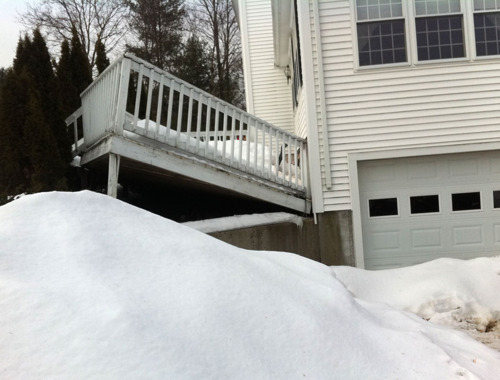Annals of Forensic Carpentry, Vol. 1, No. 1
Posted on 14 February 2011
The newspapers in New England have been filled with stories of roofs (rooves?) collapsing under their accumulated snow loads this winter; it’s become grimly routine. So I was somewhat heartened to see a less catastrophic version of the phenomenon in a photo Chris Hosford (one of my architectural collaborators) sent me today:

We’ve gotten used to stories of decks collapsing under the weight of large numbers of drunken party guests, so perhaps the snow did these homeowners a favor.
To the forensics, though! What happened to this little side deck? As we’ve seen before, carpentry can be (crudely) reduced to a battle between building materials and gravity. For decks, there are usually two anti-gravitational systems: the posts which rest on some kind of footings and the ledger that attaches the whole affair to the main structure. While I’ve seen all kinds of marginals post/footing arrangements, the usual failure point is the ledger, a piece of (hopefully) pressure-treated framing lumber fastened to the sidewall.
Perhaps this isn’t so surprising, since ledgers and their attachments have many obligations:
- Resist the tendency of the deck to fall straight down;
- Resist the tendency of the deck to pull away from the house;
- Provide an attachment point for the floor structure of the deck; and
- Discourage water from getting into the house.
Attaching the ledger presents two challenges: use fasteners that won’t fail, and make sure that you are attaching to something solid in the main structure. In our experience, folks often blow it on both accounts. They attach the ledger with nails, which allows it to pull away, or with deck screws, which tend to shear off. Structural bolts blessed by engineers are the right way to go here. And they don’t dismantle enough of the main house to confirm that they are attaching to intact framing members.
Water presents the third big challenge. Even if everything else was done correctly, if water migrates behind the ledger, the sheathing and framing in the main structure can rot, making the first two issues moot. This is easily avoidable with careful flashing (the subject of a future article; perhaps many…), but time, effort, and knowledge are prerequisites.
So what happened to the little-deck-that-couldn’t? I haven’t visited in person, but the photo suggests that the deck fell straight down rather than pulling away and then falling. My guess is that either the fasteners failed outright under the snow load, or that the sidewall of the house had gotten punky from years of water incursion, and the rotted sheathing crumbled under the snow load.
Tagged: deck, porch, snow load, structural failure, winter
